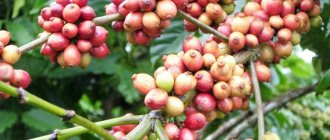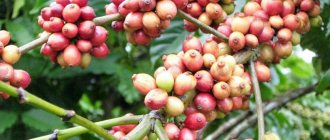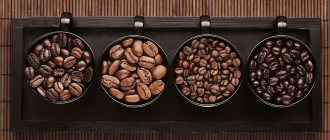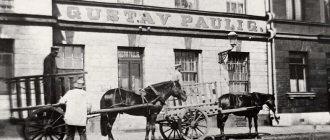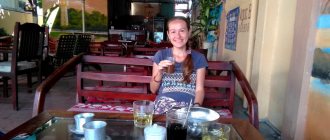According to world statistics, Finland ranks first in the world in coffee consumption. For Finns, coffee is not just a tradition or a daily ritual, but a kind of addiction and habit, without which they cannot imagine their life. Finns prefer weak coffee and do not add anything extra to it, and even in coffee shops you can rarely find the drink divided into espresso, latte and other types.
Coffee in Finland is of high quality, and therefore tourists often take a pack or two with them to please themselves at home and get a taste of Finnish life. We will tell you further which brands and types of coffee to pay attention to in Finland.
Coffee from Paulig
The Paulig concern is the leader in coffee production in Finland. Most popular brands belong to him.
Finnish coffee Juhla Mokka
The most famous brands of Paulig coffee and their degree of roasting (strength):
- Juhla Mokka (1) and Juhla Mokka tumma paahto (2) are ideal for evening gatherings with friends;
- Presidentti (1) and Paulig Presidentti tumma paahto (3) for preparing a “celebratory” drink with a mild taste;
- Brazil (2) from the Brazilian variety of santos beans;
- Presidentti Black Label (4) with a chocolate aftertaste thanks to Kenyan Arabica;
- Presidentti Gold Label (4) premium blend of Arabica beans from Ethiopia and Papua New Guinea;
- Parisien Coffee (5) made from robusta beans, usually drunk with milk.
In addition to the listed brands, the Paulig line includes Arabica, Espresso, and Mokka coffee blends of varying degrees of roasting and taste.
Finnish coffee brands
The most favorite brands of Finns, which can be purchased in almost every supermarket, are: Paulig and Meira. Let's look at each in more detail.
Coffee Paulig
This is a well-known coffee producer, which also occupies a leading position in Finland. It is famous for its high quality, and the coffee of this brand is a mixture of different, carefully selected varieties.
Paulig Juhla Mokka
It is considered the most common brand in Finland. Juhla is translated from Finnish as holiday, and, indeed, this particular coffee is an indispensable attribute at coffee breaks and parties. The degree of roasting is low, indicated by number one. The line also includes stronger options - with two, two and a half, and four roasts.
Paulig Presidentti
Along with the above brand, it is the successor to the very first coffee brand of this company. It is a mixture of Arabica varieties from the countries of Ethiopia, Kenya and Central America. Famous for its exquisite aroma and light aftertaste. Roasting degree one or three. Also in this series are mixtures of coffee from certain countries (Indonesia, Brazil, Tanzania, etc.) with high and medium degrees of roasting. Paulig Brazil, medium strength, was patented specifically for the Finnish market.
In addition to the brands listed above, Paulig produces blends of different types of coffee with varying degrees of roasting and strength of taste.
Coffee Meira
This brand is considered the second most popular in Finland. Meira is a Finnish company specializing in the production of coffee and spices. It is part of the Italian coffee company - the largest in Europe. This poppy has won the love of the Finns due to its good taste and low price. The main representatives of this brand are:
Kulta Katriina is a soft and delicate lightly roasted coffee (from one to three), with a slight sourness as an aftertaste.
Saluda - the degree of roasting of Arabica beans from Latin America is also the weakest (one), has a mild taste.
Coffee Lidl
Finland also has a supermarket chain called Lidl, which produces Arabica coffee under its own brand: Hieno Kahvi with roast two and Fin Mokka with roast three.
Meira
The second most popular coffee brand in Suomi is Meira. Finns love it for the good taste of the drink and low prices.
Finnish coffee Saludo
The most famous brands of Meira coffee and their degree of roasting:
- Saludo (1) from Arabica beans grown in Latin America;
- Kulta Katriina (1-3) with a slight sourness due to the presence of robusta.
How much does coffee cost in Finland?
Paulig Presidenti is considered the most expensive of the traditional coffees, Paulig Juhla Mokka represents the middle price segment, and Meira Kulta Katriina is the cheapest.
The average cost of a pack weighing 500 g is:
- Paulig Presidentti: 4-5 euros
- Paulig Juhla Mokka: 3-4 euros
- Paulig Brazil: 5-5.5 euros
- A pack of Meira Kulta Katriina or Meira Saludo will cost 3.5 euros.
- A half-kilogram pack of Swedish Lofbergs will cost just over 4 euros.
- The cost of Lidl's own brands will be no more than 3 euros per 500g pack.
Coffee from Sweden
There is quite a lot of Swedish coffee in Finnish stores. The most popular products are from the Gevalia brand, which is a supplier to the Swedish royal court. Gevalia coffee is offered in roasts from 2 to 4, has a delicate aroma and taste without sourness.
Coffee Gevalia
The products of the Swedish brand Lofsberg Lila are also made from Arabica. The Kharisma brand allows you to get a drink with a nutty aftertaste, and Magnifika - with a chocolate aftertaste.
Story
The Finns first tried coffee only in the 18th century. The very first cup, to be precise, was drunk in Vyborg. The Lutheran Church viewed coffee as a very dangerous innovation and banned it. But, cup by cup, coffee has become very fashionable among wealthy Finns. In 1750, there were about 130 admirers of this drink in Helsinki. Most often these were representatives of the upper strata - rich Swedes. And after 100-200 years, coffee became an integral part of the Finnish lifestyle. Every kitchen had a coffee grinder, and the strong aroma of coffee became a sign of wealth. This point is well reflected in the famous story “For Matches” (Tulitikkuja lainaamassa) by Maiju Lassila, where the plot itself is built around the fact that Antti Ihalainen’s family ran out of matches, and his wife sent him on a quest to make coffee.
In 1876, the German Gustav Paulig founded the company of the same name. Initially, the company dealt only with the import of coffee beans to Finland. Popular coffee brands Juhla (“Holiday”) and Presedentti (“President”) appeared in 1929. Then, for the first time in Europe, coffee was packaged in the usual packs. The time of World War II is remembered in Finland as a period of acute shortage of coffee drink. Now in Finland, giving a pack of coffee as a gift is a sign of respect.
Where can I buy
There are departments with coffee from Finnish and Swedish brands in every supermarket. There are also specialized coffee shops. To be fair, prices are often lower in supermarkets. But in specialized stores they will tell you in detail about each type of coffee.
When choosing which package of coffee to buy, you need to pay attention not only to the popularity of the brand and the degree of roasting. If you buy coffee not in beans, grinding is important, which determines the recommended preparation method. It is usually indicated by a small design of a cup, a Turk, or a coffee machine on the package.
Coffee ritual in Finnish
Finns' love of coffee is so strong that the country has two official coffee breaks (kahvitauko). They are specified in every employment contract. At this time all work stops. Even a huge queue won’t stop you from closing the reception window for a 15-minute coffee break.
The peculiarity of the coffee ritual in Finland is the leisurely conversation. They don’t drink the drink in one gulp, but sip in small sips, talk, and think about plans. If guests come, it would be rude not to offer coffee.
Finns prefer light roasting, which results in less caffeine in the beans. Therefore, drinking large amounts of coffee per day does not seriously harm their health. And lovers of the strong drink go to a specialized coffee store, because regular grocery stores sell mostly light-roasted beans.
Interestingly, in Finnish coffee shops it is possible to ask for a second cup of coffee. It will be given for free or for only 50 cents. To do this you need to say “santsikuppi”. And the code word “maitovara” means that you need to leave room for milk or cream due to the fact that most often additives are not used. They don’t particularly like instant coffee either, only if they’ve run out of natural coffee.
Since 2013, coffee shops in Finland have increasingly offered filter coffee. And in the most advanced establishments they brew in an aero-press, siphon and Chemex.
Features of the coffee ritual in Finland
Finnish coffee is not so much a tradition as it is an addiction and a habit. According to statistics, Finns drink more coffee than any other people in the world - about 12 large cups daily. True, their drink - kahvi - is no different in strength and is more reminiscent of an Americano. Finns do not use any additives, and if they do use them, it is extremely rare. Finnish style does not imply anything superfluous, and therefore in their coffee shops there is practically no division between latte, espresso and other types of drink.
Pikakahvi - instant coffee - is not particularly liked by Finns: they drink it extremely rarely. The drink is prepared using drip coffee makers by passing water through roasted ground coffee beans collected in a paper filter.
Separately, it is worth mentioning “Scandinavian roasting” - beans roasted in this way turn out to be a soft light brown hue, and the drink is weak and calm. Each product package sold in Finland is marked on the reverse side according to the degree of strength, that is, the degree of roasting of the beans - from 1 to 5. Buy strong Finnish ground coffee, reviews of which can be found not only on the Internet, but also in coffee shops, with a degree Roasting more than 1 or 2 beans is extremely difficult.
Which brand to choose
Thanks to its variety of characteristics, instant coffee from Finland is suitable for any taste and situation.
A cup of “celebratory” mocha will fit perfectly into a cozy friendly company or a team during another working day. A pleasant aroma will lift your spirits and lighten the mood.
The original “President” is light roasted, which is best drunk in the morning, trying to slowly taste the taste of blackcurrant. The “black” variety, made from deeply roasted Guinea beans, is needed by those who have a hard day ahead of them. In order to survive it, you need a large amount of energy, which will be replenished with Black Label coffee brought from Finland.
“Brazil” will lift your spirits just by the look of the packaging. Bright yellow with green patterns, it connects the buyer with Brazilian culture. The mild taste without bitterness will delight fans of light versions of the Finnish drink.
Instant Parisian coffee with milk is suitable for a comfortable evening at home. You can spend it watching French comedies or serious Provencal cinema.
The sour “Katrina” and “Saludo” are designed to be enjoyed in the morning, then taken with you to a coffee shop, sipped during a break, and finished off the day with them. You can drink these coffee drinks wherever and whenever you want.
Due to roasting, Hieno Kahvi ground coffee from Finland is too strong for regular use. You should resort to it in rare cases and under no circumstances drink it all day, otherwise you may develop problems with blood pressure. A cup of aromatic Hieno and a strip of dark chocolate in the morning is a great option for Lidl.
Tips for choosing
An interesting observation regarding coffee is made by those who visit Finland. They drink the invigorating drink in this country in very large quantities, but it is very light coffee, which has a much gentler effect on the body than a traditional strong drink. Even in cafes, they most often serve the product of the first and second degrees of roasting, and it is very difficult to find “four” or “five”. If you are a connoisseur of a particularly strong drink, order the Robert Paulig Tumma Paahto variety at the cafe.
Store shelves are decorated with all kinds of packaging of coffee and cappuccino products, and it is worth trying the varieties that Finns love so much, for example, Juhla Mokka and Presidentti. Although reviews from those who like to visit Finland and always bring a couple of packs of the drink with them say that it is always interesting to learn and discover new varieties, because the coffee here is of very high quality. This does not mean that Finnish coffee cannot be purchased in Russia, it is simply unlikely that you will be able to find such a variety of varieties as in Finland itself.
Social rituals
In Finland, you can drink coffee alone, admiring nature, or in company, but it is not at all necessary to maintain a polite conversation. Coffee breaks often take place in complete silence.
Finns always offer coffee to guests and carefully ensure that the mug is never empty. If the guest wants to break this vicious circle, he should ask for “half a cup” - this will be a sign to the hostess that no more addition is required.
Of course, coffee is served at all celebrations and events, including sporting events, election campaigns, excursions or travel.
Finns love coffee and Moomins, so they often combine these two passions by depicting funny characters from Tove Jansson's fairy tales on coffee cups. And to drink coffee in the forest, at a campsite or on a hike, they have a separate type of mug - kuksa.
Kuksa – Finnish travel mug
Which Finnish stores sell coffee?
To buy coffee, you should turn to well-known supermarket chains.
- Lidl is one of the most widespread stores in Finland. There are more than 170 branches throughout the country. It has a favorable pricing policy: German Lidl is a budget option for purchasing. The supermarket is open until nine in the evening and has a wide selection of products, which adds to its popularity. The franchise's homemade coffee is sold freely.
- S Group is a retail chain located in the Baltic countries, Finland and Russia. “S” regularly offers discounts on food products.
- K-citymarket has a history of half a century. This is the largest franchise in Finland, often combining hypermarkets with coffee shops in its branches. “K” is in first place in providing Finns and tourists with the cheapest coffee in the country - with a promotion it is possible to buy “Paulig” for just two euros.
Finland can be considered a leader in coffee consumption; the average Finn drinks at least five cups of coffee per day. According to the International Coffee Association ICO, there are 12 kg of coffee per person in Finland per year, while, for example, in Italy, famous for its love of coffee, only 5.7 kg per person. Even the Finnish work schedule always includes a coffee break (kahvitauko).
History of coffee in Finland
The Finns have loved coffee since the 18th century; the first ships with coffee beans arrived in Turku in 1720. Despite the prohibitions of the Swedish king and the Lutheran Church, which was extremely disapproving of the new drink, coffee was brewed in secret. In 1801, restrictions were lifted, but coffee remained the privilege of a select few.
Everything changed in 1876, when Gustav Paulig, who came to Finland from Lübeck, Germany, founded a company selling colonial goods and groceries, which is still family owned. Coffee became more accessible, and the company was doing so well that in 1904 Paulig opened the first coffee roasting plant in Helsinki.
To mark the 25th anniversary of the coffee roaster, the company introduced the first Paulig brands: Presidentti and Juhla, predecessors to the current Juhla Mokka and Presidentti. Before this, only license plates were used to identify coffee blends, but since 1931, a new product from Paulig - ground coffee - appeared on store shelves. At the same time, it was decided to indicate the production date of the product on the packaging for the convenience of the consumer.
In 2010, a coffee museum was opened at the modern Paulig plant in the Vuossaari region, which presents the history of coffee in Finland.
Roasting degrees
Don't know which coffee blend to choose? Tip from the barista: pay attention to the degree of roasting - this is what determines the taste and aroma of the coffee. The lighter it is, the stronger the sourness in the taste. Conversely, dark roasted coffee has a richer taste with bitterness. Typically, the coffee roasting process takes 5-8 minutes at a temperature of 180°C-240°C.
Traditionally, Finnish coffee is labeled according to five roast levels: from the weakest, or “1,” to the strongest, “5,” often with a sign that looks like a clock dial. The divisions characterize the degree of roasting of the coffee.
Grinding
When preparing coffee, it is important to choose the correct grind, as well as the dosage, because the taste of the finished drink depends on the correct preparation.
The degree of grinding depends on the selected coffee preparation method. For the convenience of customers, packages of ground coffee are marked with symbols indicating the recommended preparation method. If you do not adhere to them, for example, using coffee that is too finely ground in a drip coffee maker, the result will be burnt and bitter-tasting coffee. If you use coffee that is too coarsely ground for espresso, the result will be very far from real espresso.
If the packaging shows a “regular teapot”, the coffee is intended to be brewed in a teapot or coffee pot. You see the symbol “glass teapot for drip coffee maker” - accordingly, use a filter coffee maker. This option is very popular in Finland.
Electric filter coffee makers, which prepare coffee in 5-7 minutes, appeared in the 50s of the 20th century: a person pours cold water into a reservoir, pours ground coffee into a cone-shaped paper filter, closes the lid and presses a button. The water heats up, rises through the tube, and enters the filter with coffee. The finished drink flows drop by drop into the coffee pot.
Proportion for filter coffee from Paulig barista: 65 g of medium-ground coffee per 1 liter of water.
You can often see an image of a French press on the pack. The process of preparing coffee in a French press occurs by steaming and then squeezing. This method is also called piston. A French press is a narrow glass beaker. Coffee is poured into it and boiling water is poured into it. Then, using a piston attached to the lid, the coffee is squeezed out, leaving the grounds at the bottom of the glass. For French press, coarsely ground coffee is preferable. It is best to use elite coffee varieties for this brewing method, as they have a complex aroma that is fully revealed during brewing.
Finnish coffee brands
The most famous brands that can be bought in almost any, even small supermarket are Paulig Juhla Mokka, Paulig Presidentti, Meira Kulta Katriina, Meira Saludo. These are traditional brands of coffee that are drunk every day at work and at home. Finns have a point of national pride - among the abundance of other goods, they will always choose their own, Finnish, firmly confident in the unsurpassed and stable quality of goods produced in their country.
Presidentti is the most expensive of the traditional coffees, Juhla Mokka is in the middle price range, Kulta Katriina is the cheapest. There is also cheaper coffee in Finland, such as S-Market's own brand Pirkka, but it is not as popular. Typically, cheaper coffees have a slight sour taste.
Paulig
Paulig coffee is deservedly popular among Russian buyers. The main supplying countries for Paulig coffee are Brazil, Colombia, Peru, Guatemala, Kenya and Ethiopia. Paulig is known throughout the world as a buyer of high quality coffee, and the concept of “Paulig quality” is well established among coffee sellers and producers. Paulig coffee is a carefully composed mixture, or blend, of several varieties of coffee grown in different countries. The flavor profile of each blend is carefully thought out.
Juhla Mokka
Probably the most popular Finnish coffee brand, along with Presidentti, the successor to the company's first coffee brand. An eternal companion to all coffee breaks, presentations and gatherings with guests. The degree of roasting is very weak - one. If you like weak coffee, then this is the perfect choice. By the way, Juhla means “holiday” in Finnish. Also presented are “Juhla Mokka tumma paahto” with a roast level of two and a half, a stronger Juhla Mokka tosi tumma (roast – 4) and organic Juhla Mokka Luomu (roast – 2). Price: from 3.95 euros per pack of 500 g.
Presidentti
Presidentti is renowned for its subtle aroma, smooth taste and excellent aftertaste, thanks to an exquisite blend of Arabica varieties from Central America, Kenya and Ethiopia. Roast level - one. For those who like it “stronger” - Paulig Presidentti tumma paahto with roasting level three. Price: from 4.69 euros per pack of 500 g. Presidentti Gold Label and Black Label A special blend created for the 80th anniversary of the company - light, refined Gold Label with floral notes and luxurious dark Black Label. Price: from 6.19 euros per pack of 500 g.
Presidentti Indonesia, Colombia, Tanzania, New Guinea
Original blends of the best grades of medium and strong roasted coffee. For connoisseurs who prefer coffee from plantations in certain countries. Price: from 6.19 euros per pack of 500 g.
Brazil
Proprietary coffee for the domestic Finnish market only. Made from Brazilian Arabica Santos beans. The taste of the drink is rich, medium strength. Brazil Original has a roast level of 2, the stronger Brazil Dark Roast is 3.5. Has a special UTZ coffee certificate, i.e. its production is environmentally friendly and socially oriented in developing countries. Price: from 5.25 euros per pack of 500 g.
Mundo
Mundo has a light flavor with notes of brown sugar and honey. Organic Arabica coffee grown in the highlands of Central America. Roasting degree - 3. The stronger Mundo Reilusti Tumma with a full, rich taste has a roasting degree of 4. Price: from 4.95 euros per 400 g pack.
Watsa-kahwi
Watsa-kahwi is made using carefully selected coffee beans from South America and Asia. A special roasting method that reduces the acidity of the coffee provides a smooth, rich taste. Price: from 4.65 euros per pack of 400 g.
City coffee
Inspired by the color of famous cities, Paulig has released a new line of natural coffee. It included Paulig Café Paris, Paulig Café Havana, Paulig Café New York, Paulig Café Barcelona, Paulig Café Sydney. Each “city” has its own degree of roasting, an amazing rich taste and bright, attractive packaging. Such different cities, with their own special atmosphere and urban habits, are united by an undeniable love for coffee, which, of course, is also drunk in different ways.
Let's note Paulig Café Paris - coffee with a strong "French" roast (degree 5), rare for Finland. If you add milk, you get a traditional French café au lait. Price: from 5.65 euros per pack of 500 g.
Meira
Meira Oy is a Finnish company specializing in the production of coffee and spices. It is part of the Italian Massimo Zanetti Beverage Group, which is the largest coffee company in Europe. The first Meira coffee roastery opened in 1914.
Kulta Katriina
The Kulta Katriina brand has been produced since 1937. Kulta Katriina Perinteinen (traditional) - lightly roasted coffee, very soft and delicate. The aftertaste has a slight sourness. There are also stronger Kulta Katriina tumma paahto (roast 3) and tummempi tumma (roast 4) on sale. The Kulta Katriina line also includes organic Luomu coffee. Price: from 3.45 euros per pack of 500 g.
Saludo
Meira Saludo entered the market in 1960 and is the fourth most popular brand in Finland. It has a mild taste, the lightest roasting level, 1. Price: from 3.49 euros per pack of 450 g.
Löfbergs
Löfbergs Lila is one of the largest family-owned coffee companies in the Nordic countries, founded in 1906 by brothers Joseph, Anders and John Löfberg. Today it is run by the third and fourth generations of the family. The main office and one of the roasting plants are located in the Swedish city of Karlstad, in addition, coffee production is open in Norway, Denmark and Latvia.
Löfbergs Lila Kharisma
Dark, strong coffee roasted 4 with a nutty aroma and fresh hints of citrus. The blend uses the best Arabica beans from Brazil, Ethiopia and Central America. Price: from 4.15 euros per pack of 500 g.
Löfbergs Lila Jubileum
The blend uses spicy Arabica beans from the Brazilian plateau, as well as beans from the highlands of East Africa, Colombia and Central America. Medium roast 3, fruity notes in the aftertaste. Price: from 4.15 euros per pack of 500 g.
Löfbergs Lila Magnifica
Full-bodied coffee with a hint of cocoa and delicate notes of vanilla. Selected grains from South and Central America, East Africa and Southeast Asia. Medium roast coffee. Price: from 4.15 euros per pack of 500 g.
Since coffee is an essential commodity for Finns, you will find a large selection of coffee in regular Finnish supermarkets. Sometimes, to attract customers, stores even offer huge discounts on coffee.
Share link:
- Tweet
- Telegram
- by email
